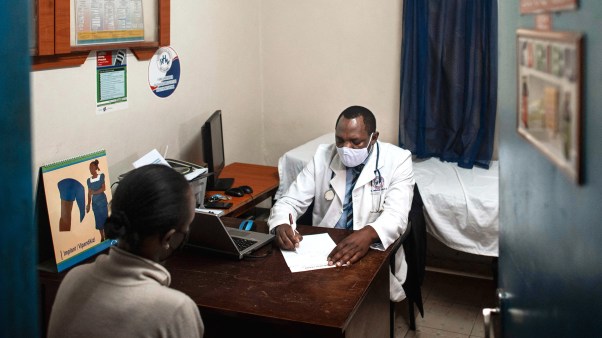When Emmanuel Nabieu started working at the Child Rescue Centre in Sierra Leone, he was, in a way, coming home.
Sixteen years earlier—July 4, 2000—the orphanage had taken him in.
At nine years old, his life was upended by civil war. His father was killed during an attack on his village, and he was separated from his mother in the chaos that followed. The stability of his extended family structure was shattered. The last living relative he knew of, an uncle, couldn’t afford to care for him.
An orphanage seemed like the only option. He was brought to the Child Rescue Centre. And from that point on, that was his home.
“I lived in a nice children’s home with all the facilities,” Nabieu, or Nabs, as he is now known by everyone, told CT. “But I really longed to be loved.”
When Nabieu grew up and went to school at Njala University in Sierra Leone and then the University of South Wales, he learned that 80 to 90 percent of orphans—like him—had a living family member who could care for them with the right resources and support. Looking at the files at the Child Rescue Centre in 2016, he was shocked to discover that 98 percent of the children cared for by the ministry had had a living family member.
“The orphanages … were not really serving orphans,” said Nabieu, who wrote about his experience and his vision for caring for children in My Long Journey Back Home. “They were just serving children from poor families.”
Nabieu proposed a radical change. He said the Child Rescue Centre didn’t need to give children new homes. It needed to figure out how to help families care well for their own children.
Today, the center has transformed. It is now called the Child Reintegration Centre, and its programs focus on helping families become financially self-sufficient. This includes classes, financial loans, and mentoring to give people the skills to succeed.
“We needed to be able to help those children build a better future—a happier future that included their families, included the communities they belonged to,” Nabieu said.
The 21st century has seen a shift within institutions and government organizations away from institutional care for children. In 2019, the United Nations passed a resolution prioritizing family-based care and calling for the eventual elimination of all orphanages, or “institutional homes.” Every member state signed on to the resolution, and organizations around the world have been making changes.
Elli Oswald, executive director of Faith to Action, a group committed to rethinking orphan care, said there is also a “growing movement of Christians who are moving away from the overuse of residential care and turning towards preventing children from entering residential care at all.”
This is motivated in part, she said, by research showing that institutional care leads to higher rates of poverty and relationship problems into adult years.
“Most children who spend a significant amount of time in orphanages are really struggling,” she said. “What we know is that children grow best in the love and care of families.”
That’s not to say institutions are never the answer.
According to Oswald, there are situations where it is unsafe for a child to go home. And there are cases when a child is truly, completely alone. A short-term stay in residential care, followed by a more permanent placement with a family, may be in the best interest of a child.
But most of the time, orphanages have solved a symptom of a problem instead of addressing the problem itself.
“Poverty is the underlying reason why children end up in orphanages,” Oswald said, “and if we can come around families to support them, they most often are able to care for these children.”
Jedd Medefind, president of the Christian Alliance for Orphans, a nonprofit that works with more than 250 organizations addressing the needs of vulnerable children, said that historically, orphanages were established quickly to respond to an overwhelming emergency. Well-meaning people felt compelled to act immediately in response to war, plagues, or other catastrophes, even if they were aware of potential drawbacks.
But people are rethinking the balance between efficiency and ideal care.
“We need to point to the ideal while also acknowledging we’re working in a very broken world,” Medefind said. “We need to embrace workable solutions.”
Even in the US, which has many more resources than developing countries, institutional care hasn’t been eliminated, Medefind noted. More than 10 percent of children in the foster system are in group homes. Some cannot be put with family members because of addiction or abuse issues. There’s a shortage of foster families, and some children with intensive needs are difficult or sometimes impossible to find placements for.
Medefind supports “a full continuum of care in every place that prioritizes family.”
This starts with family-strengthening services to prevent separation in the first place, he said. Then there should be a foster care and adoption system. And in the rare cases where placing a child in a home isn’t possible, Medefind supports family-like residential care, where children are kept in group homes with a small ratio of children to adults. Those adults would ideally remain involved in the children’s lives even into adulthood.
“The reality is, when it comes to the development of the heart and body and soul of children, the very best place for a child is the family. You simply cannot replace that on a mass scale,” Medefind said. “At all stages of development, but especially in those early formative years of infancy and early childhood, there is a deep need to feel love.”
According to Nabieu, the change needs to start with holistic thinking. Reflecting on his own experience, he realizes now that he was not just one kid in need. He was an acute symptom of a larger problem—a problem the Child Rescue Centre could address.
One of the first people Nabieu told about his vision for transforming the center into something else was Laura Horvath, a Christian who had cared for him in the orphanage. She said that, in a way, she wasn’t surprised at his vision. Nabieu had always been a leader, and Horvath and others in the ministry had also been thinking about better ways to care for children, so they were receptive to his ideas.
Horvath was nervous about big transitions. But she was soon swept up into Nabieu’s vision.
“We quickly moved into this space of just big dreaming,” she said. “What would it look like?”
The adjusted approach was more successful than those who worked with the renamed Child Reintegration Centre could have hoped. The new programs were more cost-effective—and allowed them to help far more children. The organization went from helping about 300 orphans to helping nearly 2,000 children in more than 400 families.
Nabieu believes this holistic approach is not only practical but also biblical, since God puts the solitary in families (Ps. 68:6). He believes the place that was home for him can become a powerful tool for restoration.
“These facilities can become effective sources of hope and stability for vulnerable children and families,” he said. “It’s not only about one child. It’s about a whole family as a unit. It’s about the community.”
Adam MacInnis is a reporter in Canada.













